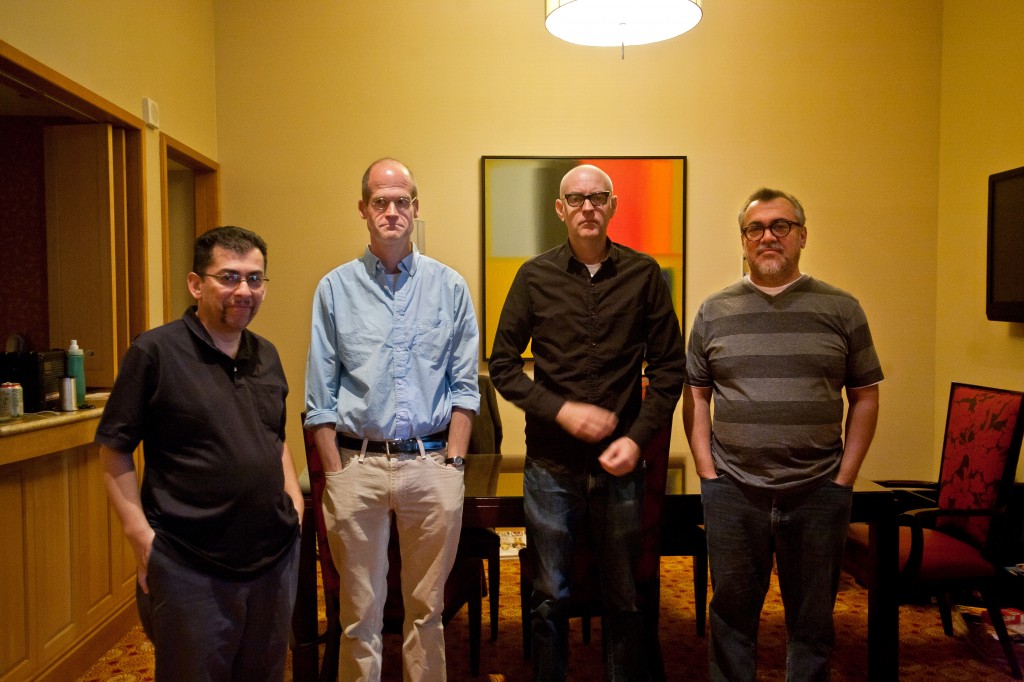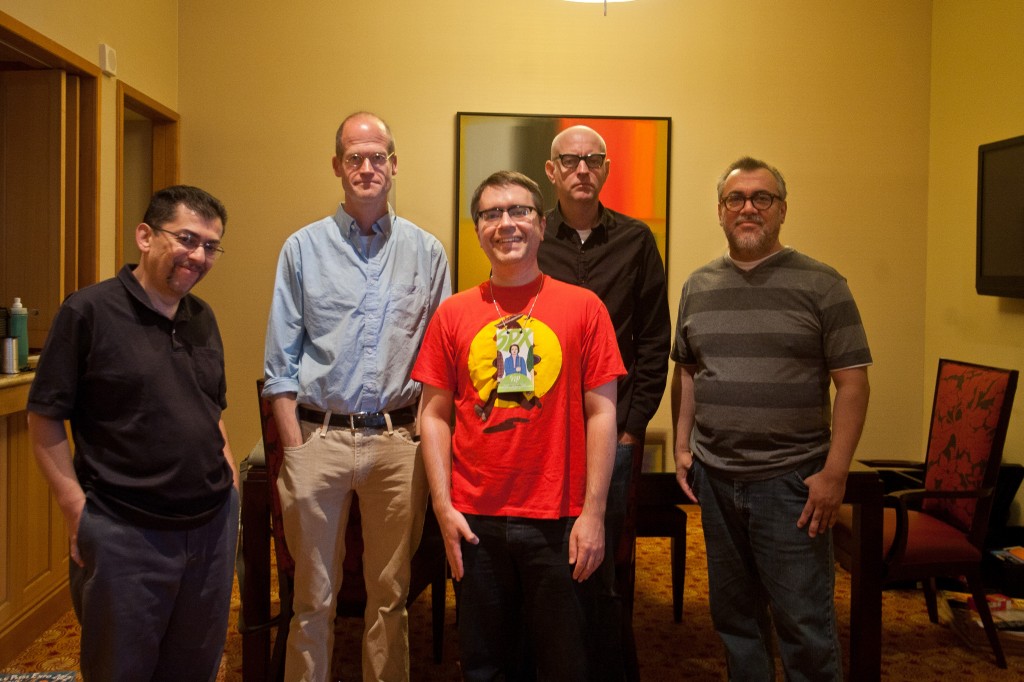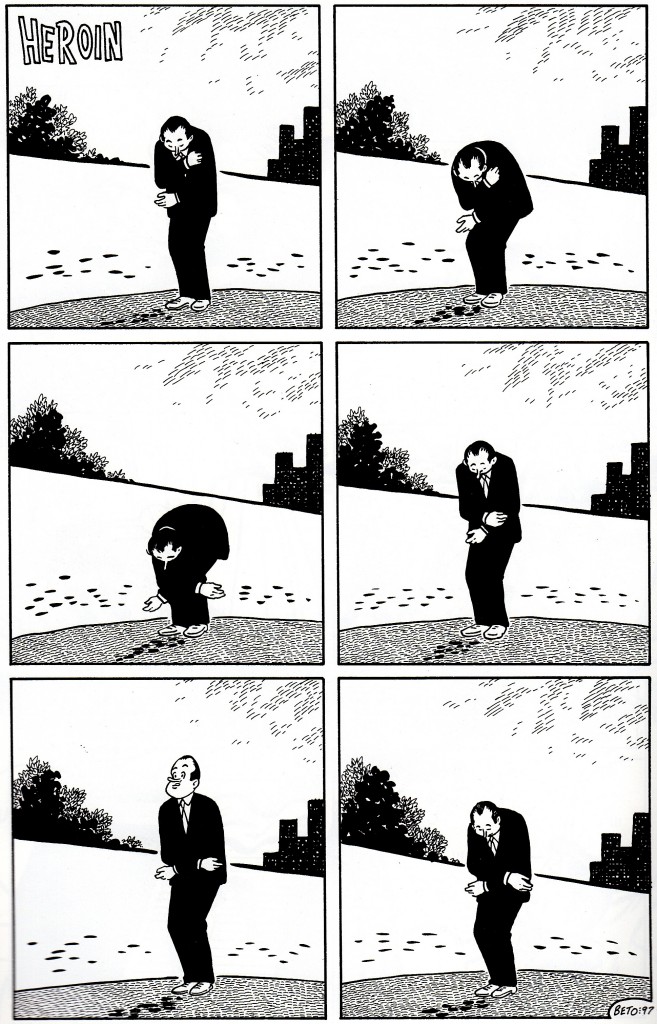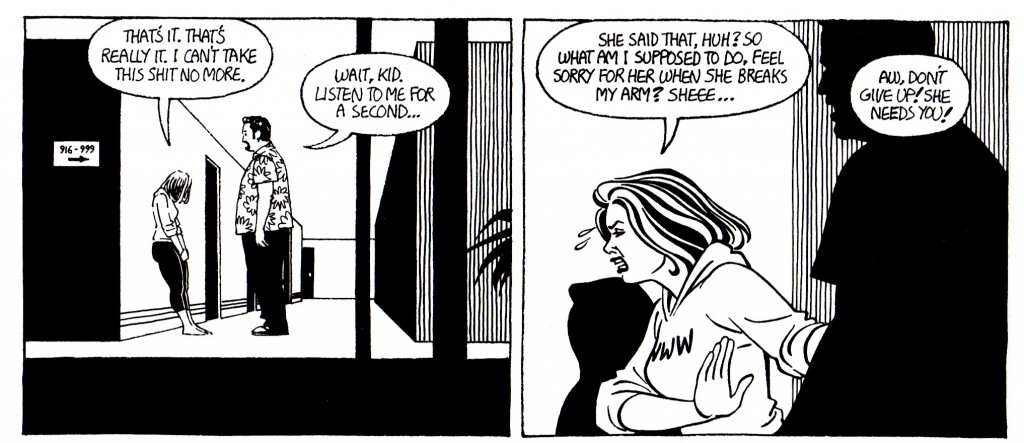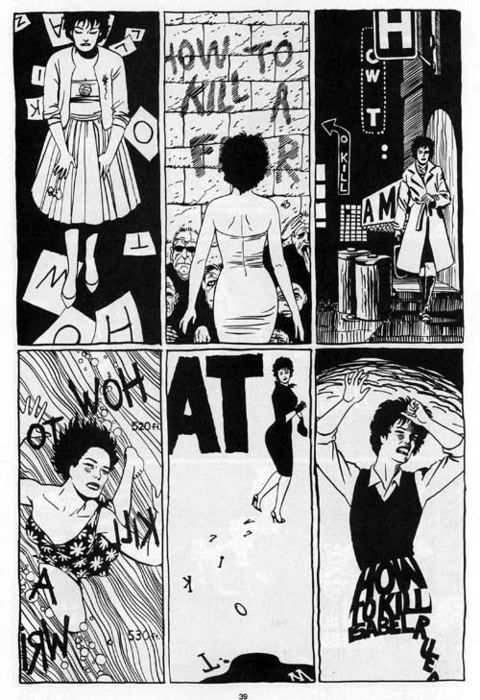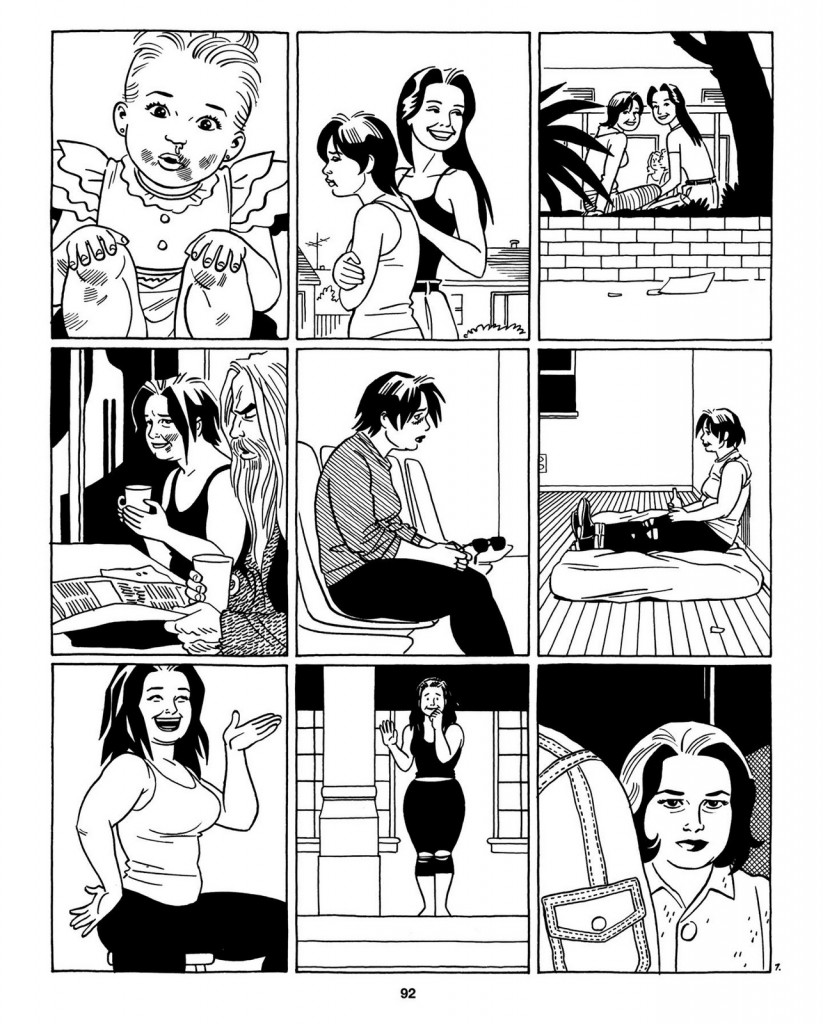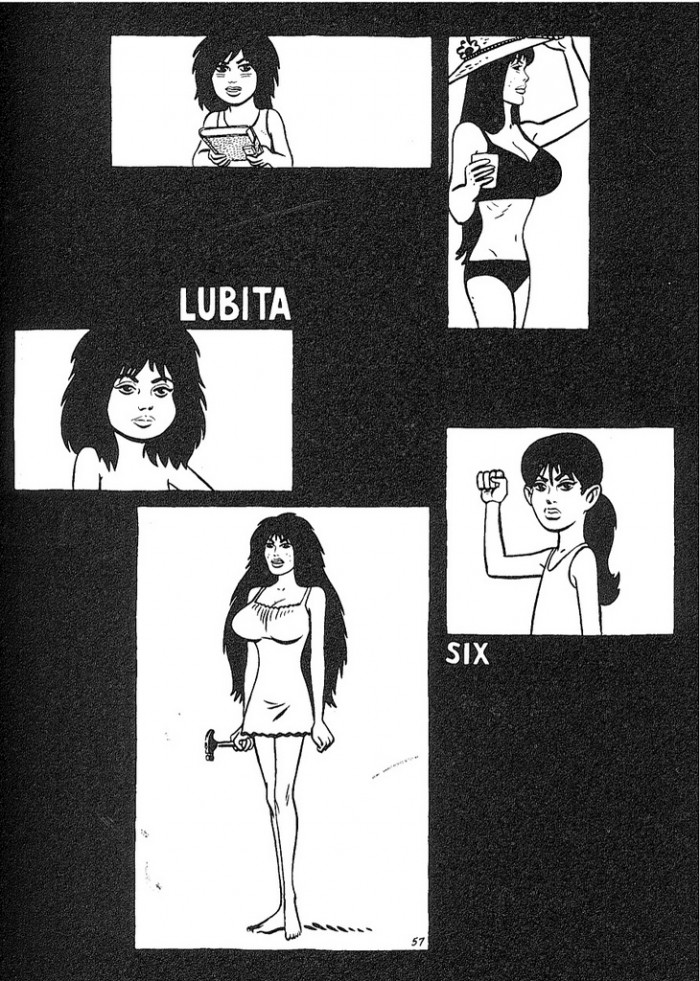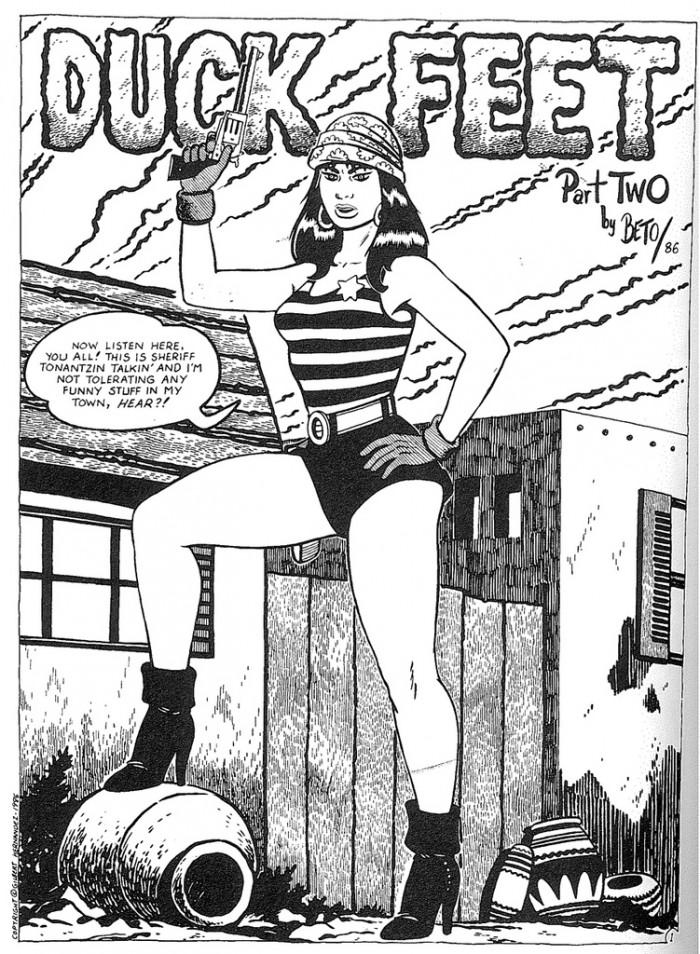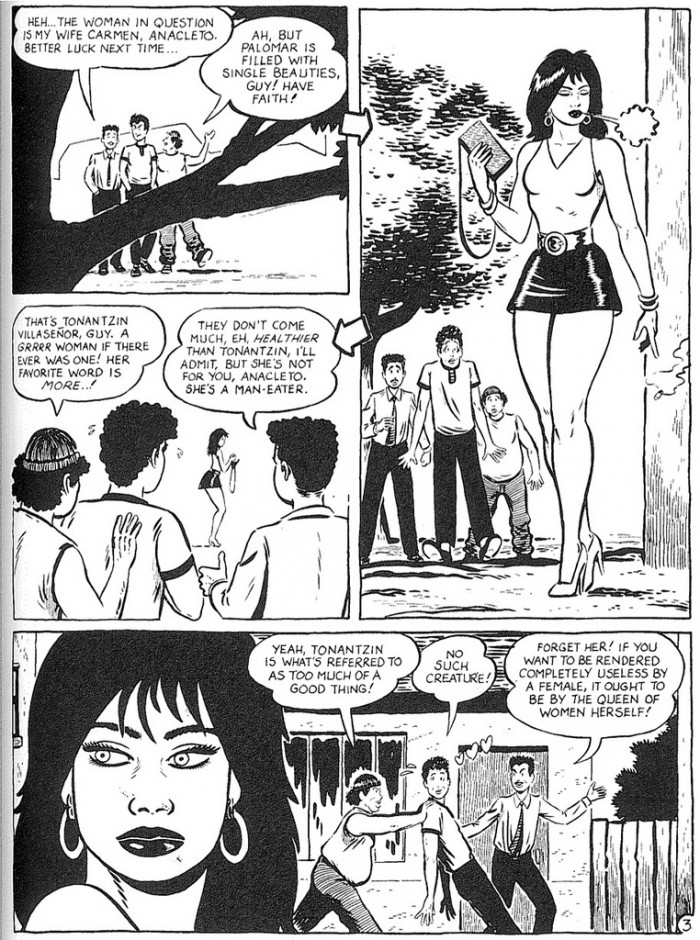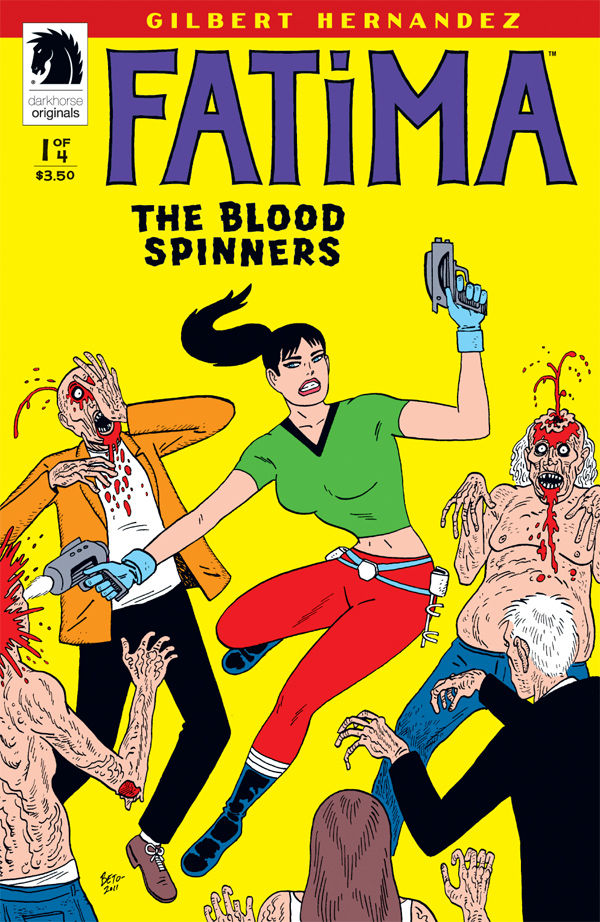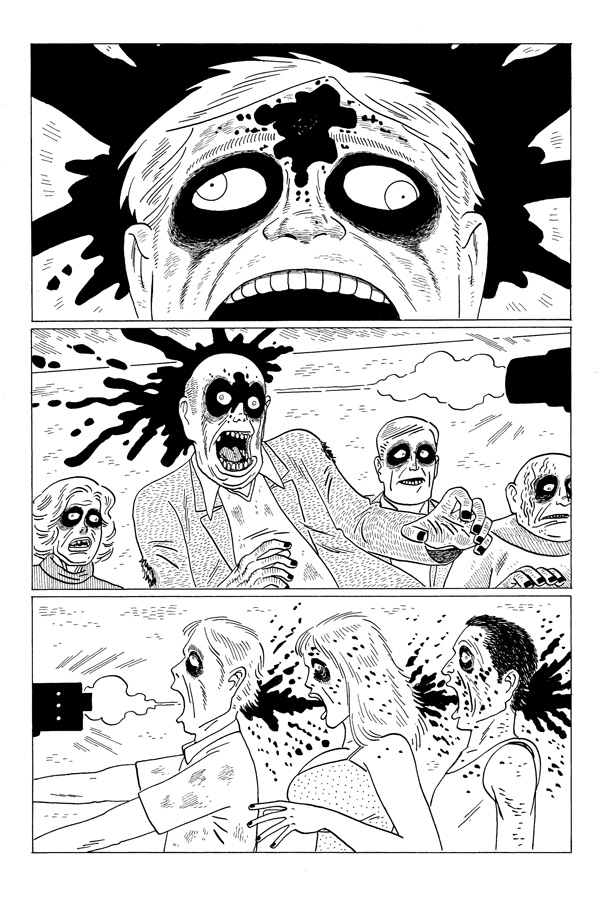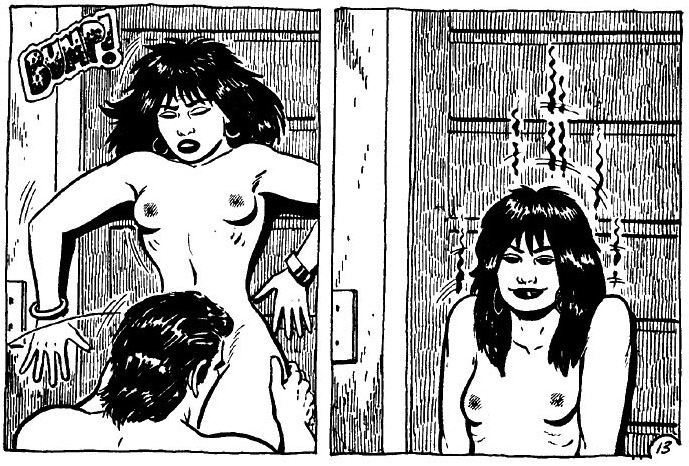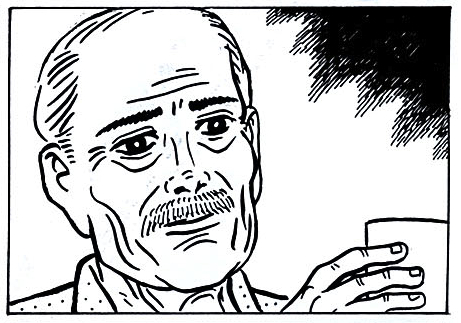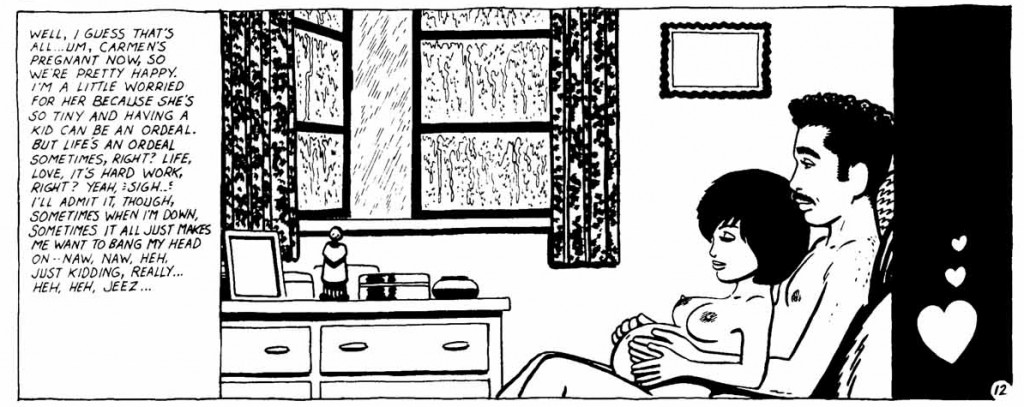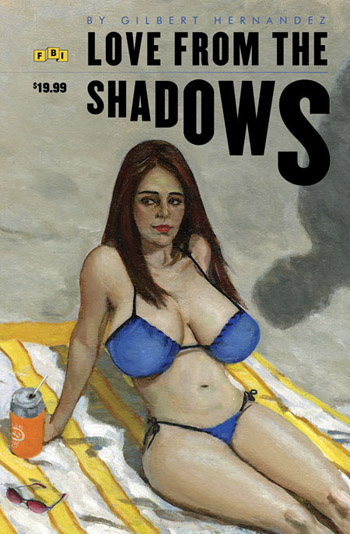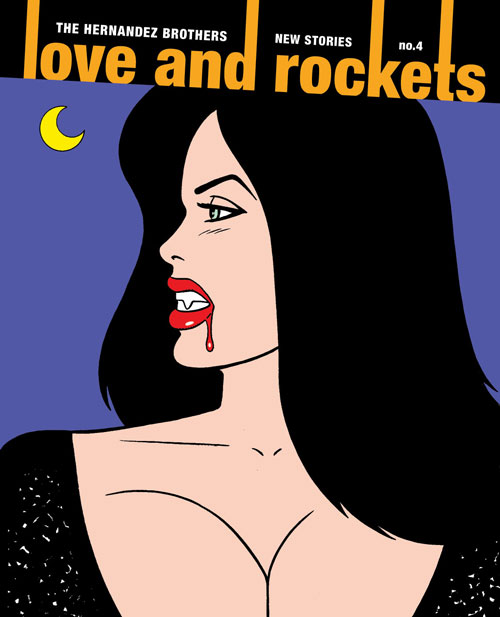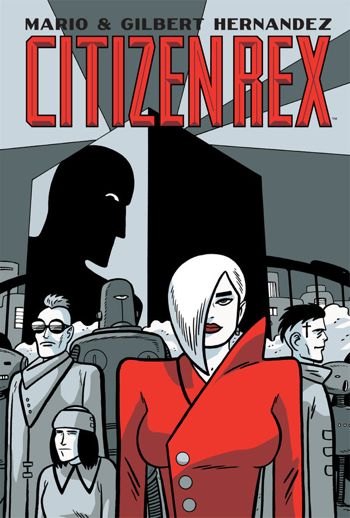Posts Tagged ‘Gilbert Hernandez’
The Gilbert Hernandez spotlight panel at SPX
October 8, 2012I hosted Gilbert Hernandez’s panel at the Small Press Expo, and here it is! I haven’t listened to it yet — how did it go?
I learned things I didn’t know before, and that’s a wonderful way to leave a panel you’re hosting.
The Four Horsemen
September 26, 2012I interviewed Jaime Hernandez, Chris Ware, Daniel Clowes, and Gilbert Hernandez for Rolling Stone. Comics game Mount Rushmore.
(photo by Meredith Rizzo)
How I spent my Saturday morning
September 18, 2012STC vs. Beto
August 16, 2012I’m honored to be moderating the Gilbert Hernandez panel at SPX in Bethesda, Maryland this year. It’s on Saturday, September 15 at 3:30pm. Hope to see you there!
Your Love and Rockets 30th Anniversary thought of the day
July 15, 2012Gilbert and Jaime are both masters of the form of comics. That’s in addition to their character work, their sheer illustrative chops, and so on; indeed it may be the most exciting thing about them. In the case of both brothers I’ve spent a long time chewing over just a few handfuls of panels, unpacking what went into them. Here’s Gilbert’s silent, six-panel comic “Heroin,” one of three one-page shorts he made with that title. It’s just a man against one of Beto’s soon-to-be-trademark dismal nowherescapes, clutching his arm, doubling over, standing back up, hunching over again. We don’t know who he is or where he is or what he’s doing or what its connection is, specifically, to the titular substance — he could be a junkie on the nod, sure, but then why is he also Richard Nixon (or maybe it’s Bob Hope)? Whether it’s about the drug specifically or addictive, destructive influences generally (as are the other two “Heroin” strips) doesn’t really matter, since the effect stems almost entirely from the building blocks of the comic itself: the man, the background, the grid layout, the lack of any text save the title, the rhythm that builds up as we watch his body contort, the three big blocks of black in each panel (trees, man, buildings), the hands pointing in opposite directions, the diagonal hill line bisecting each panel. Every element combines to convey discomfort and unease, the sense of being at the mercy of something that lets you straighten out just long enough for it to be crushing when it knocks you back down. Long before I’d actually read any comics by Los Bros I saw this page reproduced in an issue of The Comics Journal and it has worked its way into the fabric of my comics brain ever since. It occurred to me just the other day that I’ve even done a homage to it without realizing it. I think it’s a perfect comic.
And here’s two panels from “In the Valley of the Polar Bears” by Jaime. Maggie’s been working as the kayfabe “accountant” for her wrestling-champ aunt Vicki, something of a terror in and out of the ring, but the two are barely speaking. Vicki has just confided in her wrestler boyfriend Cash that the reason she’s been treating Maggie so badly is because she cares about her a lot and is hurt by Maggie’s seeming indifference in return. So here, Cash approaches Maggie to tell her about her aunt’s secret soft spot — and then blam, next panel, it’s already been told. Jaime doesn’t show us the conversation. He doesn’t slap a big “Five minutes later…” caption up there. He doesn’t alter the size of the panels or the gutters to imply the passage of time. He doesn’t cut to another scene in between. He doesn’t show Maggie and Cash in another location so that we’d know time must have passed for them to get from place to place. He zooms in a bit but other than that they’re even in the same basic spatial configuration. He pretty much breaks every rule of how jumps in time are conveyed in comics, and yet it’s still crystal clear what happened. Talk about no-fat storytelling. Why belabor the re-presentation of information we readers already have? And why monkey with shit to explain what you’re not showing us when you can simply not show it to us and assume we’re smart enough to follow? These two panels are so bold, so full of lessons in how to tell a story with comics. I think about them all the time.
Love and Rockets, the great serial comic by Gilbert, Jaime, and sometimes Mario Hernandez, is celebrating its 30th anniversary at the San Diego Comic-Con International this week. Inspired by Tom Spurgeon, this week-long, daily series of posts will highlight some of my favorite things about Los Bros Hernandez and their comics. For more information, click here.
Your Love and Rockets 30th Anniversary thought of the day
July 14, 2012Gilbert and Jaime Hernandez have each been telling the stories of the same group of characters, continuously, for three decades. They’ve done lots of other stuff, Gilbert especially, but that’s the bulk of what they’ve done. No one else in comics has done it. No one’s even come close. Could someone else do it? Could someone else tell the life story of their characters, over an actual life span, and have a lot of people care passionately about where those lives end up? I won’t say it’s unimaginable, the idea of someone else doing it, because there are enough similar cases out there for you to imagine those other people doing it, and it’s only then that the gulf between Los Bros and everyone else becomes so clear. What if Bryan Lee O’Malley just kept going with Scott Pilgrim until he hit Vol. 30? What if Dave Sim had never lost his mind? What if all the B.P.R.D. spinoffs were written and drawn by Mike Mignola? What if Achewood were a comic book and Chris Onstad never burned out on it? What if Erik Larsen’s main touchstone for Savage Dragon were Márquez rather than Kirby? What if The Walking Dead were filled with Rick-level characters, instead of Rick and a bunch of other people for Rick to react to? What if Alison Bechdel made a series of Dykes to Watch Out For graphic novels instead of memoirs? What if Harvey Pekar had made stories up instead of writing them down? What if all of these things lasted for thirty years? And oh yeah, what if all of these people had siblings doing the exact same thing at the same time under the same title? It’s only when you see all the hoops one would have to jump through even to come close to what Beto and Xaime have accomplished that you really appreciate that hey, they’re the ones who built the hoops.
Love and Rockets, the great serial comic by Gilbert, Jaime, and sometimes Mario Hernandez, is celebrating its 30th anniversary at the San Diego Comic-Con International this week. Inspired by Tom Spurgeon, this week-long, daily series of posts will highlight some of my favorite things about Los Bros Hernandez and their comics. For more information, click here.
Your Love and Rockets 30th Anniversary thought of the day
July 13, 2012Any character in Love and Rockets stands a decent chance of being my favorite on any given day, because they are designed to be contemplated, and I’m the contemplative type. Today I’m thinking a lot about Tonantzin, one of the stars from Gilbert’s Palomar stories. She’s a stunningly hot small-town girl, so her rebelliousness first manifests itself by dressing provocatively and using sex to self-actualize. But her mind, heart, and psyche are all as dangerously overdeveloped as her body and sensuality, she gets swept up in a series of increasingly destructive obsessions, first with America and Hollywood, then with native culture and political protest, then with the danger of militarism and the possibility of nuclear annihilation. We can see that they all provide her with an emotional and intellectual way out of the confines of Palomar and her own body — indeed things start getting really bad when she’s taught to read — but because he never really describes it as such, we never realize how far she’s willing to go until it’s too late. Ultimately she comes to believe the only truly free intellectual and political act is to destroy the body she came in. It’s an unforgettable and utterly unique portrait of how good ideas and good people can nevertheless combine into something very bad. It’s a lesson that life entails losing vibrant, lovely people you neither want nor expect to lose. It’s a tragedy for a young woman and the people who love her. It’s a commentary on the hopelessness of the political climate of the day. Today I find myself wondering whether if she’d grown up in Hoppers instead of Palomar, and had punk and the Locas as a release valve instead of abnegative protest, would she still be alive today? On the flip side, would Speedy Ortiz still be alive if he’d grown up in Palomar instead of Hoppers, in a place where it was easier to form romantic relationships and harder to form ones based on a shared propensity for collective macho violence? This is the kind of thing you could do all day long with character after character after character from both Gilbert and Jaime. They’re drawn to be viewed from all angles.
Love and Rockets, the great serial comic by Gilbert, Jaime, and sometimes Mario Hernandez, is celebrating its 30th anniversary at the San Diego Comic-Con International this week. Inspired by Tom Spurgeon, this week-long, daily series of posts will highlight some of my favorite things about Los Bros Hernandez and their comics. For more information, click here.
Comics Time: Fatima: The Blood Spinners #1
July 11, 2012Fatima: The Blood Spinners #1
Gilbert Hernandez, writer/artist
Dark Horse, June 2012
24 pages
$3.99
Buy it from Dark Horse
For today’s Comics Time review, please visit The Comics Journal.
Your Love and Rockets 30th Anniversary thought of the day
July 10, 2012Outside of erotica and autobiography, no cartoonist has ever woven sex so indissolubly into the fabric of his comics as Gilbert Hernandez, in a fashion reflective of lived experience. In all of fiction comics, only writer Alan Moore comes close. This goes beyond simply drawing hot people, although before unfortunate circumstances intervene, Tonantzin and Khamo are probably the hottest woman and man in all of comics. Gilbert’s ability to describe and depict physical attraction between his couples frequently makes for the sweetest and most romantic aspects of those relationships—whether male or female, characters’ appreciation for their partners’ hips, tits, dicks, thighs, stomachs, faces and what-have-you, and for the pleasure those parts bring them, is often just plain adorable, however freaky or kinky or dirty things might get. But Beto’s larger argument appears to be that we can no more separate our physical desires from our lives than we can detach from our physical bodies in the course of living them. This of course has a dark side: Life is frequently terrible, and thus so is sex in Gilbert’s comics. And so his greatest creation, Fritz, is the em-body-ment of all these aspects of Beto’s work: She is the sweetest, sexiest, kinkiest, dirtiest, most tragic character of them all. There are no sex scenes in Beto’s comics—life is a sex scene, for better and for worse.
Love and Rockets, the great serial comic by Gilbert, Jaime, and sometimes Mario Hernandez, is celebrating its 30th anniversary at the San Diego Comic-Con International this week. Inspired by Tom Spurgeon, this week-long, daily series of posts will highlight some of my favorite things about Los Bros Hernandez and their comics. For more information, click here.
The 20 Best Comics of 2011
January 1, 201220. Uncanny X-Force (Rick Remender and Jerome Opeña, Marvel): In a year when the ugliness of the superhero comics business became harder than ever to ignore, it’s fitting that the best superhero comic is about the ugliness of being a superhero. Remender uses the inherent excess of the X-men’s most extreme team to tell a tale of how solving problems through violence in fact solves nothing at all. (It has this in common with most of the best superhero comics of the past decade: Morrison/Quitely/etc. New X-Men, Bendis/Maleev Daredevil, Brubaker/Epting/etc. Captain America, Mignola/Arcudi/Fegredo/Davis Hellboy/BPRD, Kirkman/Walker/Ottley Invincible, Lewis/Leon The Winter Men…) Opeña’s Euro-cosmic art and Dean White’s twilit color palette (the great unifier for fill-in artists on the title) could handle Remender’s apocalyptic continuity mining easily, but it was in silent reflection on the weight of all this death that they were truly uncanny.
19. The League of Extraordinary Gentlemen Vol. 3: Century #2: 1969 (Alan Moore and Kevin O’Neill, Top Shelf/Knockabout): I’ll admit I’m somewhat surprised to be listing this here; I’ve always enjoyed this last surviving outpost of Moore’s comics career but never thought I loved it. But in this installment, Moore and O’Neill’s intrepid heroes — who’ve previously overcome Professor Moriarty, Fu Manchu, and the Martian war machine — finally succumb to their own excesses and jealousies in Swinging London, allowing a sneering occult villain to tear them apart with almost casual ease. It’s nasty, ugly, and sad, and it’s sticking with me like Moore’s best work.
18. The comics of Lisa Hanawalt (various publishers): As I put it when I saw her drawing of some kind of tree-dwelling primate wearing a multicolored hat made of three human skulls stacked on top of one another, Lisa Hanawalt has a strange imagination. And it’s a totally unpredictable one, which is what makes her comics – whether they’re reasonably straightforward movie lampoons or the extravagantly bizarre sex comic she contributed to Michael DeForge and Ryan Sands’s Thickness anthology, as dark and damp as the soil in which its earthworm ingénue must live – a highlight of any given day a new one pops up.
17. Daybreak (Brian Ralph, Drawn and Quarterly): Fort Thunder’s single most accessible offspring also proves to be its bleakest, thanks to an extended collected edition that converts a rollicking first-person zombie/post-apocalypse thriller into a troubling meditation on the power of the gaze. Future artcomics takes on this subgenre have a high bar to clear.
16. Habibi (Craig Thompson, Pantheon): It’s undermined by its central characters, who exist mainly as a hanger on which this violent, erotic, conflicted, curious, complex, endlessly inventive coat of many colors is hung. But as a pure riot of creative energy from an artist unafraid to wrestle with his demons even if the demons end up winning in the end, Habibi lives up to its ambitions as a personal epic. You could dive into its shifting sands and come up with something different every time.
15. Ganges #4 (Kevin Huizenga, Coconino/Fantagraphics): Huizenga wrings a second great book out of his everyman character’s insomnia. It’s quite simple how, really: He makes comics about things you’d never thought comics could be about, by doing things you never thought comics could do to show you them. Best of all, there’s still the sense that his best work is ahead of him, waiting like dawn in the distance.
14. The Congress of the Animals (Jim Woodring, Fantagraphics): The potential for change explored by the hapless Manhog in last year’s Weathercraft is actualized by the meandering mischief-maker Frank this time around. While I didn’t quite connect with Frank’s travails as deeply as I did with Manhog’s, the payoff still feels like a weight has been lifted from Woodring’s strange world, while the route he takes to get there is illustrated so beautifully it’s almost superhuman. It’s the happy ending he’s spent most of his career earning.
13. Mister Wonderful (Daniel Clowes, Pantheon): Speaking of happy endings an altcomix luminary has spent most of his career earning! Clowes’s contribution to the late, largely unlamented Funny Pages section of The New York Times Magazine is briefly expanded and thoroughly improved in this collected edition. Clowes reformats the broadsheet pages into landscape strips, eases off the punchlines and cliffhangers, blows individual images up to heretofore unseen scales, and walks us through a self-sabotaging doofus’s shitty night into a brighter tomorrow.
12. The comics of Gabrielle Bell (various publishers): Bell is mastering the autobiography genre; her deadpan character designs and body language make everything she says so easy to buy – not that that would be a challenge with comics as insightful as her journey into nerd culture’s beating heart, San Diego Diary, just by way of a for instance. But she’s also reinventing the autobiography genre, by sliding seamlessly into fictionalized distortions of it; her black-strewn images give a somber, thoughtful weight to any flight of fancy she throws at us. What a performance, all year long.
11. The Armed Garden and Other Stories (David B., Fantagraphics): Religious fundamentalism is a dreary, oppressive constant in its ability to bend sexuality to mania and hammer lives into weapons devoted to killing. But it has worn a thousand faces in a millennia-long carnevale procession of war and weirdness, and David B. paints portraits of three of its masks with bloody brilliance. Focusing on long-forgotten heresies and treating the most outlandish legends about them as fact, B.’s high-contrast linework sets them all alight with their own incandescent madness.
10. Too Dark to See (Julia Gfrörer, Thuban Press): It was a dark year for comics, at least for the comics that moved me the most. And no one harnessed that darkness to relatable, emotional effect better than Julia Gfrörer. Her very contemporary take on the legend of the succubus was frank and explicit in its treatment of sexuality, rigorously well-observed in its cataloguing of the spirit-sapping modern-day indignities that can feed depression and destroy relationships, and delicately, almost tenderly drawn. It’s like she held her finger to the air, sensed all the things that can make life rotten, and cast them onto the pages. She made something quite beautiful out of all that ugly.
9. The comics and pixel art of Uno Moralez (self-published on the web at unomoralez.com): What if an 8-bit NES cut-scene could kill? The digital artwork of Uno Moralez — some of it standard illustrations, some of it animated gifs, some of it full-fledged comics — shares its aesthetic with The Ring‘s videotape or Al Columbia’s Pim & Francie: a horror so cosmically black, images so unbearably wrong, that they appear to have leaked into and corrupted their very medium of transmission. Moralez fuses crosses the streams of supernatural trash from a variety of cultures — the legends and Soviet art of his native Russia, the horror and porn manga of Japan, the B-movies and horror stories of the States, the formless sensation aesthetic of the Internet itself — into a series of images that is impossible to predict in its weirdness but totally unflagging in its sense that you’d be better off if you’d never laid eyes on it. I can’t wait to see more.
8. The comics of Michael DeForge (various publishers): The last time you saw a cartoonist this good and this unique this young, you were probably reading the UT Austin student newspaper comics section and stumbling across a guy named Chris Ware. All four of DeForge’s best-ever comics — his divorced dad story in Lose #3, his shape-shifting/gender-bending erotica in Thickness #2, his self-published art-world fantasia Open Country, and his gorgeously colored body-horror webcomic Ant Comic — came out this year, none of them looking anything at all like anything you could picture before seeing your first Michael DeForge comic. It’s almost frightening to think where he’ll be five years from now, ten years from now…or even just this time next year.
7. The comics and art of Jonny Negron (various publishers): What if someone took Christina Hendricks’s walk across the parking lot and trip to the bathroom in Drive and made an entire comics career out of them? That is an enormously facile and reductive way to describe the disturbing, stylish, sexy, singular work of Jonny Negron, the breakout cartoonist of the year, but it at least points you in the right direction. No one’s ever thought to combine his muscular yet curiously dispassionate bullet-time approach to action and violence, his Yokoyama-esque spatial geometry, his attention to retrofuturistic fashion and style, his obvious love of the female body in all its shapes and sizes, and his ambient Lynchian terror; even if they had, it’d be tough to conceive of anyone building up his remarkable body of work in such a short period of time. Open up your Tumblr dashboard or crack an anthology (Thickness, Mould Map, Study Group, Smoke Signal, Negron and Jesse Balmer’s own Chameleon), and chances are good that Negron was the weirdest, best, most coldly beautiful thing in it. It’s like a raw, pure transmission from a fascinating brain.
6. The Wolf (Tom Neely, I Will Destroy You): Neely’s wordless, painted, at-times pornographic graphic novel feels like the successful final draft to various other prestigious projects’ false starts. It’s a far less didactic, more genuinely erotic attempt at high-art smut than Dave McKean’s Celluloid; a less self-conscious, more direct attempt at frankly depicting both the destructive and creative effects of sex on a relationship via symbolism than Craig Thompson’s Habibi; a blend of sex and horror and narrative and visual poetry and ugly shit and a happy ending that succeeds in each of these things where many comics choose to focus on only one or two.
5. The Cardboard Valise (Ben Katchor, Pantheon): Prep your time capsules, folks: You’d be hard pressed to find an artifact that better conveys our national predicament than Ben Katchor’s latest comic-strip collection, a series of intertwined vignettes created largely before the Great Recession and our political class’s utter failure to adequately address it, but which nonetheless appears to anticipate it. Its message — that blind nationalism is the prestige of the magic trick used by hucksters to financially and culturally ruin societies for their own profit — is delightfully easy to miss amid Katchor’s remarkable depictions of lost fads, trends, jobs, tourist attractions, and other detritus of the dying American Century. He’s the very most funnest Cassandra around.
4. Love from the Shadows (Gilbert Hernandez, Fantagraphics): I picture Gilbert Hernandez approaching his drawing board these days like Lawrence of Arabia approaching a Turkish convoy: “NO PRISONERS! NO PRISONERS!” In a year suffused with comics funneling pitch-black darkness through a combination of sex and horror, none were blacker, sexier, or more horrific than this gender-bending exploitation flick from Beto’s “Fritz-verse.” None also functioned as a rejection of the work that made its creator famous like this one did, either. Not a crowd-pleaser like his brother, but every bit as brilliant, every bit as fearless.
3. Garden (Yuichi Yokoyama, PictureBox): Like a theme park ride in comics form — with the strange events it chronicles themselves resembling a theme park ride — Yokoyama’s book is a breathtaking, breathless experience. Alongside his anonymous but extravagantly costumed non-characters, we simply go along for the ride, exploring Yokoyama’s prodigious, mysterious imagination as he concocts a seemingly endless stream of increasingly strange interfaces between man and machine, nature and artifice. As a metaphor for our increasingly out-of-control modern life it’s tough to top. As pure thrilling kinetic cartooning it’s equally tough to top.
2. Big Questions (Anders Nilsen, Drawn & Quarterly): Last year, I wrote that if the collected edition of Nilsen’s long-running parable of philosophically minded birds and the plane crash that turns their lives upside-down didn’t top my list whenever it came out, it must have been some kind of miracle year. Turns out that it was. But you’d pretty much have to create a flawless capstone to a thirty-year storyline of neer-peerless intelligence and artistry to top this colossal achievement. Nilsen’s painstaking, pointillist cartooning and ruthless examination of just how little regard the workings of the world have for any given life, human or otherwise, marks him as the best comics artist of his generation, and solidifies Big Questions‘ claim as the finest “funny animal” comic since Maus.
1. Love and Rockets: New Stories #4 (Gilbert and Jaime Hernandez, Fantagraphics): Gilbert got his due elsewhere on my list, so let’s ignore his contribution to this issue, which advance the saga of his bosomy, frequently abused protagonist Fritz Martinez both on and off the sleazy silver screen. Instead, let’s add to the chorus praising Jaime’s “The Love Bunglers” as one of the greatest comics of all time, the point toward which one of the greatest comics series of all time has been hurtling for thirty years. In a single two-page spread Jaime nearly crushes both his lovable, walking-disaster main characters Maggie and Ray with the accumulated weight of all their decades of life, before emerging from beneath it like Spider-Man pushing up from out of that Ditko machinery. You can count the number of cartoonists able to wed style to substance, form to function, this seamlessly on one hand with fingers to spare. A masterpiece.
Love and Rockets: New Stories #4 is a great comic
October 17, 2011Comics Time: Love from the Shadows
October 5, 2011Love from the Shadows
Gilbert Hernandez, writer/artist
Fantagraphics, 2011
120 pages, hardcover
$19.99
Buy it from Fantagraphics
Buy it from Amazon.com
For reasons unknown to me, I did not create a Comics Time entry for this review, which was posted on April 20 at The Comics Journal. I’m just rectifying the situation now. Please visit TCJ.com for the review.
Comics Time: Love and Rockets: New Stories #4
August 1, 2011Love and Rockets: New Stories #4
Gilbert Hernandez, Jaime Hernandez, writers/artists
Fantagraphics, August 2011
104 pages
$14.99
Buy it from Fantagraphics
Buy it from Amazon.com
Love and Rockets: New Stories #4 will turn any fan of Los Bros Hernandez into the host of The Chris Farley Show. “Remember? That time? When you drew Calvin’s plaid shirt? So that the plaid was always facing in the same direction? No matter how much Calvin moved?…That was awesome.” I am seriously finding it difficult, if not impossible, to review this comic without simply hitting the bullets-and-numbering button and whipping up a list of everything in it that amazed me. It would be a long list, too. But I’m abstaining as much as I can — to challenge myself for starters, and to avoid spoiling the comic for those of you who haven’t yet read it (which is probably most of you since it’s not out yet) for the most part. But I’m also holding off on that listicle because I think it’s a cheat. The fact of the matter is that while reading this book I discovered that I’m at least as attached to Ray Dominguez and Fritz Martinez, the protagonists of Jaime and Gilbert’s contributions respectively, as I am to a decent number of real people in my life. So sure, I could rattle off the ways in which Xaime and Beto continually prove themselves to be among the most graphically inventive and entertaining cartoonists alive some three decades into their careers — the crosshatching on Ray’s shirt and Maggie’s sofa; Gilbert’s use of wavy, puddle-shaped, impenetrable fields of black in his vampire story; the impact of the just-this-side-of-parallel lines of Angel’s body as she bends her leg to put on a high heel; the upside-down lava-lamp shape of Fritz’s legs in a skirt, used as an anchor for panel after panel of her simply walking around town with her agent ex; dredging up a long-ago, possibly long-forgotten character, drawing him as a late-middle-aged man in a way that makes him unrecognizable until you realize just how recognizable he is; the smashed-skull-as-cubist-masterpiece in Gilbert’s customary burst of horrifying ultraviolence; the holy shit moment when you realize the visual structure to that montage spread from Jaime’s story; Gilbert storming the ramparts of the vampire story and launching sex and violence back into it like payloads from a trebuchet; Jaime serving up a story whose snapshot style echoes comparable material from “Wigwam Bam” in significant and story-relevant ways; tracing the similarities and differences between Killer and Fritz via the characters they play, the use of their amazing bodies fraught with story information. And hey, look at that, I did rattle them off! But in the end, how it looks pales in insignificance next to what happens, because making it look that good is a means to the end of imparting just how much what happens matters. Ray’s shirt and Fritz’s legs, the shadow of the vampire and the structure of the montage — they’re just landmarks to remind you where you were when you found out if Ray and Fritz and Maggie were going to get happy endings, or not. It’s the easiest thing in the world to understand, and it’s the hardest thing in the world to do, and it’s magic, pure magic, to do it this well.
Comics Time: Citizen Rex
July 26, 2011Citizen Rex
Mario Hernandez, writer
Gilbert Hernandez, artist
Dark Horse, June 2011
144 pages, hardcover
$19.99
Buy it from Amazon.com
For today’s Comics Time review, please visit The Comics Journal.
Comic of the Year of the Day: Love and Rockets: New Stories #3
December 19, 2010Every day throughout the month of December, Attentiondeficitdisorderly will spotlight one of the best comics of 2010. Today’s comic is Love and Rockets: New Stories #3 by Gilbert Hernandez and Jaime Hernandez, published by Fantagraphics — career-best work from cartoonists with two of the best careers in the medium.
On Jaime’s “Browntown”/”The Love Bunglers”:
…ever since I read it, when I think of it, I just keep thinking to myself, “Poor [name]. Poor, poor [name].” It makes me want to cry! Cry for an imaginary person I’d never read about until a few pages earlier. (It’s the flipside of feeling proud of the entirely imaginary Hopey Glass for becoming a teacher’s assistant, I guess.) Such power!…I will never forget reading this book.
On Gilbert’s “Scarlet by Starlight”/”Killer * Sad Girl * Star”:
the brutal exploitation of children at the center of “Scarlet by Starlight” — delivered in a grotesquely matter-of-fact panel, savagely angry and awful — is echoed by the far milder but still insidious sexualization of “Killer * Sad Girl * Star” later on in issue #3…and, of course, it compliments and reinforces Jaime’s “Browntown”/”The Love Bunglers” suite in that same volume.
Click here for a full review of Jaime’s contributions to the issue and click here for a full review of Gilbert’s contributions to the issue; click either one for purchasing information.
Comic of the Year of the Day: High Soft Lisp
December 18, 2010Every day throughout the month of December, Attentiondeficitdisorderly will spotlight one of the best comics of 2010. Today’s comic is High Soft Lisp by Gilbert Hernandez, published by Fantagraphics — Gilbert Hernandez vs. Gilbert Hernandez, to the death.
I’ve never seen a cartoonist so thoroughly dismantle–discredit–his own artistic preoccupations.
In High Soft Lisp, Gilbert traces the relationship history of Fritz Martinez, the ultimate sex goddess in a career full of them, and in so doing reveals that her every fetish outfit and sexual free-for-all is fruit from the poisoned tree. Lots of characters in this book enjoy the living shit out of Fritz’s sexuality, not least Fritz herself, but to a man and woman they’re revealed to be creepily predatory about it, embracing the worst in themselves and encouraging the worst in Fritz. And here’s the thing: What have we been doing over the hundreds of pages we’ve spent watching Fritz adorably and kinkily fuck her way through the post-Palomar cast of Beto’s comics? What has Beto been doing? What does that say about all of us?
Click here for a full review and purchasing information.
LOVE AND ROCKTOBER | Comics Time: Love and Rockets: New Stories #1-3 and “Dreamstar”
December 8, 2010Love and Rockets: New Stories #1-3
featuring various stories by Gilbert Hernandez, writer/artist
Fantagraphics, 2008-2010
104 pages each
$14.99 each
Buy them for 33% off from Fantagraphics
Buy them from Amazon.com
“Dreamstar”
in MySpace Dark Horse Presents #24
Gilbert Hernandez, writer/artist
Dark Horse, July 2009
8 pages
Read it for free on MySpace.com (sorry, the permalink to the story isn’t working so you’ll have to scroll for it)
Buy it in MySpace Dark Horse Presents Vol. 4 from Amazon.com
“Fuck. Where’d all the good sex go? There used to be fuckin’ and sucking’ and pussy eatin’ and everything. Pussy eaten’ being my favorite. Now it’s rare to see sex much lately, unless it’s seen as sad or creepy or simply wrong. Shit, is that a cop?”–from “The Funny Papers”
“I didn’t get naked or do porn or have to suck anybody’s dick!! OK?!!”–from “Sad Girl”
“The naked maniac guys, the bloody cop, my up-the-butt daisy dukes…camera behind me getting a good close-up…I’ll take what I can get.”–from “Killer * Sad Girl * Star”
“They’re only animals! You did it! You did it too!”–from “Scarlet by Starlight”
The suite of stories Gilbert Hernandez contributed to the relaunched, graphic-novel-format Love and Rockets: New Stories might be his most complex work yet. By my count, you have two relatively straightforward strips, “Sad Girl” and “Killer * Sad Girl * Star,” starring Killer, Guadalupe’s teenage daughter and heir to the Luba/Fritz/Petra bombshell genes. You have a Fritz B-movie, “Scarlet by Starlight.” You have a movie Killer starred in, “Hypnotwist,” which was a remake of an earlier film we’re told; two other Killer movies are woven into “Killer * Sad Girl * Star.” You have an abstract strip called “?” with which “Hypnotwist” shares much of its visual vocabulary. You have a strip that’s similar in tone to his bleaker Palomar morality plays, “Papa,” and a similarly cold America-based strip called “Victory Dance.” Then you have a funny-animal goof called “Never Say Never,” an exercise in ’60s-style humor cartooning called “Chiro El Indio” that’s written by brother Mario, a trio of newspaper strips called “The Funny Papers,” and a kill-crazy rampage by the Martin & Lewis impersonators from Bela Lugosi Meets a Brooklyn Gorilla (seriously!) called “The New Adventures of Duke and Sammy.” Finally, there’s “Dreamstar” from Dark Horse’s defunct webcomics site at MySpace.com, which is still another film from Killer’s oeuvre.
It was only in reading Beto’s stories in all three volumes that the Chinese puzzle-box intricacy of what he’s doing here revealed itself to me. Much of this is accomplished by delaying the point at which we receive vital information. In “Hypnotwist,” we don’t see Killer appear until a pair of pages deep into the strange, wordless strip. Up until then we’ve been focusing on the imagery the strip shares with the previous volume’s “?”–giant smiley faces, a tumbling glass, ducks, a door with a question mark; meanwhile, the meager information about Killer’s first movie we learned in “Sad Girl”–it involved a lot of green-screen work and running in place in a trenchcoat designed to make her look nude underneath–doesn’t tip us off about anything in “Hypnotwist” until Killer herself shows up. “Scarlet by Starlight,” meanwhile, never tips its hand, not even with subtle deviations like the hair-color games Chris Ware played with his similar sci-fi/horror story-within-the-story in ACME Novelty Library #19. Unless you happen to remember the title from Fritz’s strips, or the endpages in The Troublemakers and Chance in Hell, there’s no way to tell it’s a “movie” from the Palomar-verse until you see Killer watching part of it in the following strip. Fritz herself is buried under cat-person make-up and her humanoid speech doesn’t give her lisp occasion to manifest. (I know she has other identifying characteristics, but let’s face it, when it comes to deducing the identity of Beto characters, “giant breasts” hardly narrows it down.) In “Killer * Sad Girl * Star,” one of the movies Killer stars in is presented in such a fashion that it seems to be real life. “Victory Dance” starts out like a non-narrative exploration of figurework a la “Heroin” from Fear of Comics before becoming a story about a relationship haunted by the spectre of death and one member’s fleeing from it a la “Papa,” and finally revealing itself to be set in “Papa”‘s world. “Papa,” meanwhile, could be a Palomar-verse strip for all I know–I’d need to go back and see if mudslides or poisonous worms were ever a feature of Palomar’s surroundings. “The New Adventures of Duke and Sammy” plays “Papa” and “Victory Dance”‘s relationship/travelogue tragedies as farce. “The Funny Papers”‘ sub-strip “Meche” evokes a key backstory element in the Fritz comics, while “It’s Good to Be…” (quoted above in its entirety) seems to be a direct commentary on Beto’s current approach to sex in his comics. As is custom, the films we see the characters acting in are all reflective of the issues of sexuality that dominate their own lives. Specfically, the brutal exploitation of children at the center of “Scarlet by Starlight”–delivered in a grotesquely matter-of-fact panel, savagely angry and awful–is echoed by the far milder but still insidious sexualization of “Killer * Sad Girl * Star” later on in issue #3…and, of course, it compliments and reinforces Jaime’s “Browntown”/”The Love Bunglers” suite in that same volume. All in service of what feels like an extension of the flagellating self-critique we saw in High Soft Lisp, the quotes above being Exhibit A.
And I could probably go on! But to do so would be to imply that trainspotting is the primary value of these comics. I could just as easily enumerate the innumerable pleasures of Gilbert’s cartooning itself in these strips: The wire-thin, unwavering line with which he draws the legs of the protagonist of “Hypnotwist,” say–a style I’ve never seen him use before. That choreography in “Victory Dance.” The emergence of vast, hellish landscapes as a no-doubt-about-it theme in Gilbert’s work with the opening of “Papa.” The dead-behind-the-eyes facial expressions of the humans in “Scarlet by Starlight.” The sequence in “Hypnotwist” where a balloon-headed man’s head is popped, leaving it sagging horrifically off his neck as he crawls in the nude. The WTF repetition of the Masonic square and compass. The unexplained holes in Papa’s head. Killer as a heavy-lidded Luba lookalike. Hector as a wild-eyed gray-haired hot-tempered eminence grise.
All told, you could wrap these stories up between two covers and come up with a book of absolutely crushing intelligence, emotional heft, and visual power–a book among the best of Gilbert’s career. And by #3, Jaime is hitting a similar career peak, playing off of similarly uncompromising themes. Here I am at the end of over two months of reading nothing but going on three decades’ worth of Love and Rockets, and neither I nor Los Bros Hernandez are anywhere near exhausted. All hail.
LOVE AND ROCKTOBER | Comics Time: Chance in Hell
November 29, 2010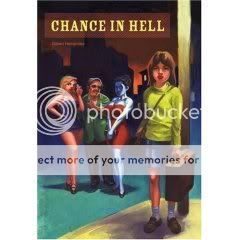
Chance in Hell
Fantagraphics, September 2007
Gilbert Hernandez, writer/artist
120 pages, hardcover
$16.95
Buy it from Fantagraphics
Buy it from Amazon.com
(Note: I originally posted this review on January 18, 2008. This was before I’d read much, if any, of Gilbert’s Fritz material from Love and Rockets. I think the review holds up, which is why I’m re-running it; but with all of Beto’s post-Palomar Palomar-verse work under my belt now, if anything I find Chance in Hell, both its content and its very existence, even more disturbing. On a story level, the “movie” from which the graphic novel is “adapted” turns out to be a “what-if” for its co-star Fritz (whose prostitute character in it doesn’t have a speaking role), featuring a protagonist whose life easily could have been Fritz’s if her mother Maria had been just a bit more heartless or her father Hector just a bit more awful. But that right there’s the thing: Gilbert basically takes the single worst thing ever done by anyone in any of his stories, turns up the volume on it, and builds a new, even more violent and hideous story around it. “Some carry the pit in them for the rest of their lives,” says the book. And later: “There’ve been people who’ve survived, but each has carried with him a distinct odor for the rest of his life. A unique smell that he could never remove. Like mine. Like the smell I carry and must mask with a special cologne of my own design. Is there something you must mask?”)
—
Rough, rough stuff from the creator of Palomar. Hernandez is in the midst of creating graphic novels based on the B-movies that his Palomar-verse character Fritz starred in, but “B-movie” might give you the wrong impression here. This isn’t one of those howlers the bots made fun of on MST3K–it’s the kind of disturbing, unpleasant film starring and shot by unknowns that you might rent on a whim from the horror or European section of your old neighborhood video store, watch, and spend the rest of the evening worried about the mental health of cast and crew. The story concerns Empress, an orphaned toddler abandoned in a sprawling, dog-eat-dog garbage dump and raped so frequently that she doesn’t even seem to notice anymore. A farcical string of bloodily violent incidents leads her to a life as the unofficially adopted daughter of a poetry editor who claims to have come from the same circumstances, and then eventually to a second life as the wife of a young district attorney, but in both cases violence and squalor cling to her like a stench, to use a frequently invoked metaphor.
This is the angriest I can ever recall Gilbert’s art looking. That’s saying something: My wife, for example, finds his books almost difficult to look at–“His characters just look so hard,” she says, and they’ve never been harder than here. Right from the get-go his figures seem dashed off as in a white heat, while several early landscapes and backgrounds in the hellish dump look like the whole world is on fire. His almost supernaturally confident pacing of scenes and the cuts between them evoke in their matter-of-factness the acceptance of everyday brutality by the characters themselves. At times the jumpcuts can be quite funny, as when a scene between Empress and her adopted father consists solely of a pair of panels where they argue over whether a glass is half empty or half full; both Hernandez and his characters know how reductive this exchange is, yet also know it’s quite true to who they are.
But when that metronomic editing slows down, the effect is powerful, particularly because it is often done to draw out scenes of gutwrenching violence or tragedy. (The centerpiece scene in the brothel is as disturbing as the death squad attack in Gilbert’s masterpiece Poison River; there as here a knowing glance is all-important, but here it causes murder rather than prevents it.) The end of the book changes the pacing again, revving up the jumpcuts to suggest unsolved crime and unglued minds, and to be honest I’ve revisited it three or four times today and I’m still not sure what’s going on. Maybe that’s a problem, maybe it’s not. Since I see myself revisiting this book, a gruesome, enraged commentary on just how shitty things can be, many, many times in the future, I’m leaning toward “not a problem at all.”
LOVE AND ROCKTOBER | Comics Time: New Tales of Old Palomar #1-3
November 26, 2010New Tales of Old Palomar #1-3
Gilbert Hernandez, writer/artist
Coconino/Fantagraphics, 2006-2007
32 pages each
$7.95 each
Buy them from Fantagraphics
Buy them from Amazon.com
By the end of his post-Palomar Love and Rockets comics, Gilbert often draws his characters like they’re the only people on earth. Their acts are isolated against a blank background, or they parade themselves in front of us and address us directly like B-movie actresses at a convention panel or motivational speakers on an arena stage. They’re larger than life and spotlit as such.
New Tales of Old Palomar reminds us that life goes on around them, and the earth surrounds them. Beto’s contribution to the Igort-edited Ignatz line of international art-comic series, these three issues present a suite of stories from Palomar’s past. They fill in a few notable lacuane–where Tonantzin and Diana came from, what was up with the gang of kids we’d occasionally see who were a few years older than the Pipo/Heraclio group, how Chelo lost her eye. A lot of this turns out to be really fascinating, especially if you’ve spent a month immersing yourself in the Palomar-verse. But to me it’s not what’s told that matters, but how it’s told. Maybe it’s seeing Gilbert work at magazine size again, maybe it’s the creamy off-white paper stock, maybe it’s the thinner, finer line he’s using, but New Tales simply feels different than anything we’ve seen from Beto in years.
Once again characters are rooted in the streets of Palomar and the wilderness beyond, stretching off in all directions. Indeed the wilderness, as much as I hate to use this cliché, is as much a character in these stories as anyone or anything else: It’s vast, almost abstractly so at times, and it houses at least as many mysteries as Fritz’s backstory. Gilbert uses it to bring the strip’s mostly forgotten supernatural and science fiction elements back to the foreground–ghosts and spirits on one hand, and sinister “researchers” on the other. And these in turn tie in to long-abandoned plot threads: Tonantzin’s slow-burning madness, say, or the hinted-at Cold War experiments that seem to have quietly unleashed genuine danger in Palomar’s surroundings, or the way Palomar seems to exist as a spiritual entity quite aside from the people who happen to inhabit it. But these connections are mostly teased out, not hit with the sledgehammer emotional force of the post-Palomar comics’ equivalent sinister or macabre bits. The trick Gilbert pulls here is to persuade us, through visuals and pacing, to put aside our foreknowledge of all that comes later, all the tragedy and horror, all the manic escapades and blackness, and exchange it for a quiet, yellowed air of mystery and menace–and eventual safety, since all’s well that ends well here. The shadow is there, but it’s only that, a shadow of the crystalline moment at hand, hinting at a vast and unknowable world beyond. Beautiful stuff.
LOVE AND ROCKTOBER | Comics Time: Love and Rockets Vol. 2 #20
November 24, 2010 Love and Rockets Vol. 2 #20
Love and Rockets Vol. 2 #20
featuring “Venus and You″
Gilbert Hernandez, writer/artist
Fantagraphics, 2007
56 pages
$4.50
Out of print at Fantagraphics
Buy it as featured in the Luba hardcover from Fantagraphics
Buy it as featured in the Luba hardcover from Amazon.com
(Programming note: As I did with Jaime, I’ll be reviewing Gilbert’s contributions to the final issue of Love and Rockets Vol. 2 and (when I get to them — still a ways to go!) the first three issues of Love and Rockets Vol. 3 on their own. Click here read about the Jaime half of this comic.)
In order to read this story, I had to turn to my massive Luba hardcover, which I believe collects all of the post-Palomar Palomar-verse stories in chronological order. I sorta wish I’d realized this going into my read-through of all Gilbert’s work, since it’s obviously how I prefer to read this stuff. But for the purposes of a review-a-thon like this it wouldn’t have made much sense to consume this material in one giant hardcover. I wouldn’t have been able to do the whole gigantic work justice in one go, especially compared to the more manageable chunks in which I read the rest of Los Bros’ work; besides, no way could I have maintained my schedule by reading the thing in two days.
But flipping through the book to get to the final post-Palomar story (to date, I believe), which remains otherwise uncollected, I discovered that the stories immediately leading up to this one are “Blackouting” and “Doralis.” If those titles don’t mean anything to you I won’t spoil it, but they were the two big audible-gasp, dropped-jaw, cover-gaping-mouth-with-hand moments from High Soft Lisp and Luba in America. “Devastating” just about covers it, though not quite–they’re the big black holes into which their respective storylines drop. Where could Beto possibly go from there?
The answer is “a happy ending,” of course. At long last he returns to Venus, Petra’s daughter and one of the least damaged, most well-adjusted, most self-assured characters in the whole post-Palomar oeuvre. Now a teenager, she’s virtually everything her mother and aunts never got to be. She has a healthy, fun-sounding sex life with her boyfriend, who also happens to be her best friend of many years’ standing. She gets along great with her mother and both her aunts despite their estrangement. Her personal segment of the extended family seems quite secure — Petra has remarried to a guy who sounds swell, Petra herself put on a bunch of marriage-security weight and sounds happy herself, Venus and her kid sister get along. Venus is smart, funny, quick-witted, kind-hearted, a pretty unabashed nerd, beautiful…just a real kick-ass kid. It’s an uplifting note to end on after all this darkness.
Most uplifting at all is Venus’s power to process and contextualize her family’s story healthily. In her interactions with her mother and aunts, we see she’s able to admire their admirable qualities — and for all the horror we’ve been shown, all three sisters have plenty to admire about them, their simple survival not being the least of it — while not letting their bad sides taint her. (If that takes a bit of denial on her part, so be it.) For example, she’s revealed in this final strip to be her Tia Fritz’s number-one fan. She’s seen all of her aunt’s movies–with the possible exception of the surreal faux-porn flick from her pre-movie-star days that’s currently causing a lot of buzz. Venus dismisses it as basically unimportant compared to Fritz’s latest release, which Fritz herself wrote and directed. We the reader can see the symbolic resonance of the clip from the strange pseudo-porn movie — a man emerges from a mist-enshrouded forest to have sex with a nude Fritz, her breasts swollen by pregnancy, only to transform into some sort of beast in the middle of the act, then disappear into the background, leaving Fritz naked, disoriented, and alone. It’s her life as a sexual being, basically…and Venus doesn’t give a fuck, because she prefers the movie where Fritz is the writer-director-star. I get the feeling that Venus is equipped to be a multi-hyphenate for her own life in a way that few of the characters we’ve met have been.
Indeed, in our final glimpse of her, she asks her late family and friends — Grandma Maria, Gato, Sergio, Dolaris — to watch over the three sisters, and then provides these guardian angels’ answers to her prayers herself, same font, same caption style. Writer, director, star. I wish her all the luck in the world.

